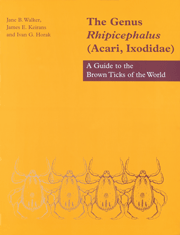Book contents
- Frontmatter
- Contents
- Acknowledgements
- 1 Introduction
- 2 Relationships of the ticks (Ixodida) and definition of the genus Rhipicephalus
- 3 Format for the accounts of individual species
- 4 Glossary
- 5 Rhipicephalus species names of the world
- 6 Rhipicephalus species occurring in the Afrotropical region
- 7 Accounts of individual species occurring in the Afrotropical region. pages 59 to 277
- Accounts of individual species occurring in the Afrotropical region. pages 278 to 490
- 8 Host/parasite list for the Afrotropical Rhipicephalus species
- 9 Rhipicephalus species occurring outside the Afrotropical region
- 10 Accounts of individual species occurring outside the Afrotropical region
- 11 Host/parasite list for the non-Afrotropical Rhipicephalus species
- 12 Species groups based on the immature stages
- 13 The transmission of tick-borne diseases of animals and humans by Rhipicephalus species
- Index
10 - Accounts of individual species occurring outside the Afrotropical region
Published online by Cambridge University Press: 05 November 2011
- Frontmatter
- Contents
- Acknowledgements
- 1 Introduction
- 2 Relationships of the ticks (Ixodida) and definition of the genus Rhipicephalus
- 3 Format for the accounts of individual species
- 4 Glossary
- 5 Rhipicephalus species names of the world
- 6 Rhipicephalus species occurring in the Afrotropical region
- 7 Accounts of individual species occurring in the Afrotropical region. pages 59 to 277
- Accounts of individual species occurring in the Afrotropical region. pages 278 to 490
- 8 Host/parasite list for the Afrotropical Rhipicephalus species
- 9 Rhipicephalus species occurring outside the Afrotropical region
- 10 Accounts of individual species occurring outside the Afrotropical region
- 11 Host/parasite list for the non-Afrotropical Rhipicephalus species
- 12 Species groups based on the immature stages
- 13 The transmission of tick-borne diseases of animals and humans by Rhipicephalus species
- Index
Summary
RHIPICEPHALUS BURSA CANESTRINI & FANZAGO, 1878
The specific name bursa, from Middle Latin meaning a “pouch” or a “purse made of skin”, refers to the bloated pouch-like appearance of an engorged female of this tick species.
Synonym
?bilenus.
Diagnosis
A large, light brown species.
Male (Figs 230(a), 231(a) to (c)
Capirulum usually slightly broader than long, length × breadth ranging from 0.66 mm × 0.71 mm to 0.88 mm × 0.88 mm. Basis capituli with short acute lateral angles in the anterior third of its length. Palps short, broad. Conscutum narrower anteriorly, broadening posterior to eyes, length × breadth ranging from 1.55 mm × 1.02 mm to 3.34 mm × 2.26 mm; the light tan body wall expanded laterally and posteriorly in engorged specimens. Eyes marginal, slightly bulging, not edged with punctations. Cervical pits deep, then extending as very shallow troughs just posterior to eyes. Punctations numerous, fine, evenly distributed over scutal surface, a few larger punctations in scapular areas. Marginal lines long and narrow, impunctate, delimiting first festoons, and almost reaching eyes. Posteromedian groove narrow, shallow and usually inconspicuous; posterolateral grooves broadly-oval shallow depressions. Ventrally spiracles elongate in anteroposterior axis, each with a short, narrow dorsal prolongation; circum-spiracular setae present. Adanal plates large, pointed anteriorly, broadly rounded posteriorly with cusps or pointed prominences on their internal margins; accessory adanal plates absent or present as very small, light-brown, sclerotized points.
- Type
- Chapter
- Information
- The Genus Rhipicephalus (Acari, Ixodidae)A Guide to the Brown Ticks of the World, pp. 523 - 584Publisher: Cambridge University PressPrint publication year: 2000



